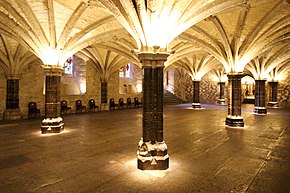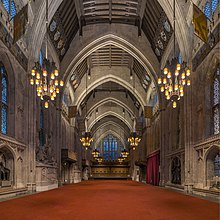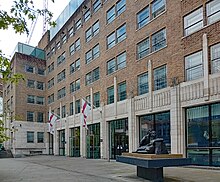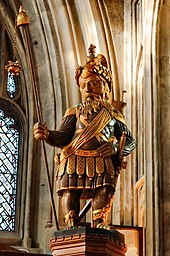Guildhall, London
| Guildhall | ||
|---|---|---|
OS grid reference TQ 32485 81384 | | |
| Area | City of London | |
| Built | 1440 | |
| Owner | City of London Corporation | |
Listed Building – Grade I | ||
| Official name | Guildhall | |
| Designated | 4 January 1950 | |
| Reference no. | 1064675 | |
Guildhall is a municipal building in the Moorgate area of the City of London, England. It is off Gresham and Basinghall streets, in the wards of Bassishaw and Cheap. The current building dates from the 15th century; however documentary evidence suggests that a guildhall had existed at the site since at least the early 12th century. The building has been used as a town hall for several hundred years, and is still the ceremonial and administrative centre of the City of London and its Corporation. It should not be confused with London's City Hall, the administrative centre for Greater London. The term "Guildhall" refers both to the whole building and to its main room, which is a medieval great hall. It is a Grade I-listed building.[1]
History
Roman, Anglo-Saxon and Medieval

During the Roman period, the Guildhall was the site of the London Roman Amphitheatre, rediscovered as recently as 1988. It was the largest in Roman Britain, partial remains of which are on public display in the basement of the Guildhall Art Gallery, and the outline of whose arena is marked with a black circle on the paving of the courtyard in front of the hall. The siting of the Anglo-Saxon Guildhall here was probably due to the amphitheatre's remains.[2] Excavations by Museum of London Archaeology at the entrance to Guildhall Yard exposed remains of the great 13th-century gatehouse built directly over the southern entrance to the Roman amphitheatre, which raises the possibility that enough of the Roman structure survived to influence the siting not only of the gatehouse and Guildhall itself but also of the church of St Lawrence Jewry whose strange alignment may shadow the elliptical form of the amphitheatre beneath.[3]
The first documentary reference to a London Guildhall is dated 1127 or 1128; archaeologists have also discovered foundations dating to around that time.[4][5] Legend describes the Guildhall site as being the location of the palace of Brutus of Troy, who according to Geoffrey of Monmouth's Historia Regum Britanniae (1136) is said to have founded a city on the banks of the River Thames, known as Troia Nova, or New Troy.[6]
The great hall is believed to be on a site of an earlier guildhall (one possible derivation for the word "guildhall" is the Anglo-Saxon "gild", meaning payment, with a "gild-hall" being where citizens would pay their taxes). Possible evidence for this derivation may be in a reference to John Parker, the sergeant of "Camera Guyhalde", London, in 1396.[7]
Current building

Construction began on the current building in 1411 and was completed in 1440 under the supervision of John Croxton.[8][5]


The Great Hall did not completely escape damage in the
Trials at the Guildhall have included those of Anne Askew (the Protestant martyr), Thomas Cranmer (Archbishop of Canterbury) and Lady Jane Grey ("the Nine Days' Queen")[13] as well as Henry Garnet (executed for his complicity in the Gunpowder Plot of 1605).[14]
The 1783 hearing of the infamous
Present use

Guildhall continues to serve as the headquarters for the City of London Corporation, with most of its offices housed in modern extensions to the north and west of the original building. The North Wing was designed by Giles Gilbert Scott and was built between 1955 and 1958, facing a new public square between Aldermanbury and Basinghall Street.[18]

The West Wing was designed by
Gog and Magog

Two giants, Gog and Magog, are associated with Guildhall. Legend has it that the two giants were defeated by Brutus and chained to the gates of his palace on the site of Guildhall. Early carvings of Gog and Magog were destroyed in Guildhall during the Great Fire of London. They were replaced in 1708 by a large pair of wooden statues carved by Captain Richard Saunders. These giants, on whom the current versions are based, lasted for more than two hundred years before they were destroyed in the Blitz. They, in turn, were replaced by a new pair carved by David Evans in 1953 and given to the City of London by Alderman Sir George Wilkinson, who had been Lord Mayor in 1940 at the time of the destruction of the previous versions.[20]
Functions
Guildhall hosts many events throughout the year, the most notable one being the Lord Mayor's Banquet, which is held in honour of the immediate-past Lord Mayor and is the first to be hosted by the new Lord Mayor of the City of London. In keeping with tradition, it is at this banquet that the
In 1992 during the Ruby Jubilee of Elizabeth II, a lunch was held at Guildhall to mark the 40th year of the Queen's reign. Elizabeth II made a famous 'annus horribilis' speech after the 1992 Windsor Castle fire and the separation of two of her children.[23]
Guildhall Bar
The members' bar in the Guildhall is a highly subsidised facility for members of the Court of Common Council and the Court of Aldermen.[24] Access to the facilities is a privilege for life, even after an individual ceases to be a member of either of these courts.[24] Members can also entertain guests there.[24] It is substantially cheaper than any other bar in the City of London, as it is subsidised from the City's Cash, a sovereign wealth fund.[24]
See also
References
- ^ a b c Historic England. "Guildhall, London (1064675)". National Heritage List for England. Retrieved 25 August 2019.
- ^ Selkirk, Andrew; Selkirk, Wendy, eds. (February 1994). "The London Amphitheatre". Current Archaeology. Vol. XII, no. 137. Friary Press. pp. 164–171.
- ISSN 1357-4442. Archived from the originalon 13 February 2011.
- ISBN 978-1441106827.
- ^ ISBN 978-0-333-67153-5.
- ISBN 978-1-84383-206-5.
- ^ Plea Rolls of the Court of Common Pleas; National Archives; CP 40/541. Year 1396; third entry.[permanent dead link]
- ^ "History". Guildhall. 25 August 2019. Archived from the original on 10 August 2020. Retrieved 14 November 2020.
- ^ The Best, by John Whitaker, p.132
- ^ Chisholm, Hugh, ed. (1911). . Encyclopædia Britannica. Vol. 12 (11th ed.). Cambridge University Press. p. 690.
- ^ Whitaker, John. A History of H.H. Martyn & Co.: Carvers in Wood, Stone and Marble. p. 132.
- ^ "Oscar Nemon and Churchill". Oscarnemon.org.uk. Archived from the original on 14 April 2016. Retrieved 24 September 2014.
- ^ "Lady Jane Grey – Famous Trials at Guildhall". Guildhall Library. 7 July 2017. Retrieved 26 August 2019.
- ^ "State Trials at Guildhall: Henry Garnett or Garnet 1555-1606". Guildhall Library. 30 May 2018. Retrieved 26 August 2019.
- Museum of London.
- ^ "Chopin's visit to Britain, 1848". The Chopin Society. Retrieved 26 August 2019.
- ^ "Marathon Route Map" (PDF). London 2012. Archived from the original (PDF) on 19 August 2012.
- ^ a b Historic England. "West Wing, Guildhall (Grade II) (1476841)". National Heritage List for England. Retrieved 22 August 2023.
- ^ "Guildhall Library". City of London. Archived from the original on 3 December 2019. Retrieved 25 August 2019.
- ^ "Gog And Magog Back In London". British Pathe. Retrieved 25 August 2019.
- ^ "The Lord Mayors of London | British History Online". www.british-history.ac.uk. Retrieved 4 June 2019.
- ^ "Worshipful Company of Carmen". Retrieved 25 August 2019.
- ^ "The true story behind the Queen's 'annus horribilis' speech shown in 'The Crown' — including what the show changed". The Insider. 16 November 2022. Retrieved 19 April 2023.
- ^ a b c d Elledge, Jonn (31 October 2017). "Like no council canteen you've ever seen: on the drinks menu at the City of London's Guildhall Bar". www.citymetric.com. New Statesman. Retrieved 5 November 2017.
Further reading
- Baddeley, John James. A Guide to the Guildhall of the City of London (Simpkin Marshall, 1898)
- Barron, Caroline M. The Medieval Guildhall of London (Corporation of London, 1974)
- Greenglass, Graham & Dinsdale, Stephen. Guildhall: City of London. History. Guide. Companion (Pen & Sword, 2018)
- Perks, Sydney. The Restoration and Recent Discoveries at the Guildhall London (1910)
- Price, John Edward. A Descriptive Account of the Guildhall of the City of London (Blades, East & Blades, 1886)
- Welch, Charles (intro.) Catalogue of the Collection of London Antiquities in the Guildhall Museum (1903)
External links
![]() Media related to Guildhall, London at Wikimedia Commons
Media related to Guildhall, London at Wikimedia Commons
- City of London Corporation homepage on Guildhall Archived 19 March 2016 at the Wayback Machine

